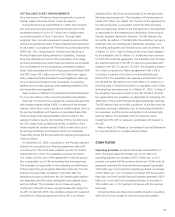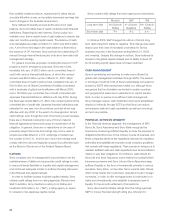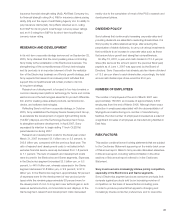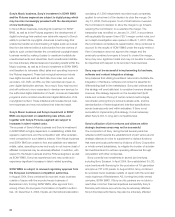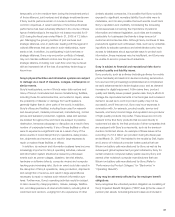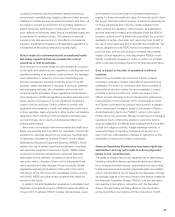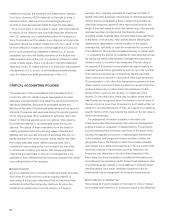Sony 2007 Annual Report Download - page 88
Download and view the complete annual report
Please find page 88 of the 2007 Sony annual report below. You can navigate through the pages in the report by either clicking on the pages listed below, or by using the keyword search tool below to find specific information within the annual report. 85
acceptance of other competing productions by the public,
and the availability of alternative forms of entertainment and
leisure activities.
Sony’s Pictures segment is subject to labor interruption.
The Pictures segment is dependent upon highly specialized
union members who are essential to the production of motion
pictures and television programs. A strike by one or more of
these unions could delay or halt production activities. Such a
delay or halt, depending on the length of time involved, could
cause delay or interruption in the release of new motion pictures
and television programs and thereby could adversely affect
revenues and cash flows in the Pictures segment.
Sony’s Financial Services segment operates in a highly
regulated environment and new regulations and regulatory
initiatives could adversely affect the flexibility of its business
operation.
Sony’s Financial Services segment operates in industries subject
to comprehensive regulation and supervision, including the
Japanese insurance and banking industries. Future develop-
ments or changes in laws, regulations or policies and their
effects are unpredictable and could lead to increased compli-
ance expenses or limitations on operations. For example,
Japan’s Financial Services Agency recently required all life and
non-life insurance companies to perform and report on system-
atic reviews of non-payment of insurance claims, the results of
which could lead to additional rulemaking.
In conducting prudent asset liability management, Sony’s
Financial Services segment is subject to risks from market
fluctuations in the value of investments, changes in customer
demand and potential variability in insurance claims.
If Sony’s Financial Services segment fails to conduct effective
ALM to balance possible risks and expected returns on invest-
ment assets with its financing liabilities and underwriting risks
on insurance policy benefits, its ability to provide competitive
products and services to customers may deteriorate and its
profitability may decline. Sony Life, which constitutes the largest
portion of this segment, has liabilities to policyholders with a
long average duration, making ALM more challenging. This
segment also may incur losses from decreases in the value of
securities and other financial instruments purchased for invest-
ment purposes resulting from fluctuations in interest rates or in
equity markets. In addition, Sony’s Financial Services segment
faces a risk of changes in customer demand including a change
from more profitable protection-orientated products, such as
term insurance, to less profitable savings-oriented products,
such as individual annuities, as well as a risk of unpredictable
increases in insurance claims.
Differences between actual and assumed policy benefits
and claims may require Sony’s Financial Services segment
to increase policy reserves in the future.
Sony’s life insurance and non-life insurance businesses
establish policy reserves for future benefits and claims based
on regulatory guidelines and estimates of future payment
obligations made by qualified actuaries. The insurance busi-
nesses calculate these reserves based on many assumptions
and estimates, including the frequency and timing of the event
covered by the policy, the amount of benefits or claims to be
paid and the investment returns on the assets they purchase
with the premiums received. These assumptions and estimates
are inherently uncertain, and the insurance businesses cannot
determine with precision the ultimate amounts that they will be
required to pay for, or the timing of payment of, actual benefits
and claims or whether the assets supporting the policy liabilities
will grow at the level they assume prior to the payment of
benefits or claims. The frequency and timing of the event
covered by the policy and the amount of benefits or claims
to be paid are subject to a number of risks and uncertainties,
many of which are outside of the insurance businesses’
control, including:
•changes in trends underlying the insurance businesses’
assumptions and estimates, such as mortality and morbidity
rates and automobile accident rates;
•the availability of sufficient reliable data and the insurance
businesses’ ability to correctly analyze the data;
•the insurance businesses’ selection and application of
appropriate rating and pricing techniques; and
•changes in legal standards, claim settlement practices,
medical care expenses and automobile repair costs.
If the actual experience of the insurance businesses is less
favorable than their assumptions or estimates, reserves may be
inadequate. In addition, any changes in regulatory guidelines or
standards with respect to the required level of policy reserves
may require that the insurance businesses establish policy
reserves based on more stringent assumptions, estimates or
actuarial calculations. Such events could result in a need to
increase provisions for policy reserves, which may have a
significant adverse effect on the financial condition and results
of operations of the Financial Services segment.




